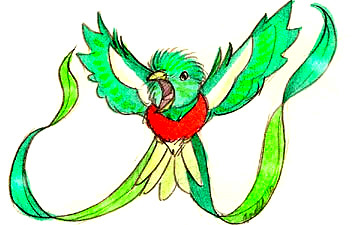The Resplendent Quetzal, Pharomachrus mocinno, is a spectacular bird of the trogon family. It is found from southern Mexico to western Panama (unlike the other quetzals of the genus Pharomachrus, which are found in South America and eastern Panama). There are two subspecies, P. m. mocinno and P. m. costaricensis, the Costa Rican Resplendent Quetzal. This quetzal plays an important role in Mesoamerican mythologies.
The “song” is a treble syllable described as kyow or like “a whimpering pup”, often in pairs, which may be repeated monotonously. Resplendent Quetzals have other unmusical calls as well.
Resplendent Quetzals are considered specialized fruit-eaters, although they mix their diet with insects (notably wasps, ants, and larvae) and frogs. Particularly important are wild avocados and other fruit of the laurel family, which the birds swallow whole before regurgitating the pits, which helps to disperse these trees.
Their habitat is montane cloud forests of Central America (from Southern Mexico to Panama). Resplendent Quetzals usually live alone when not breeding. When breeding, females lay two pale blue eggs in a nest placed in a hole which they carve in a rotten tree. A tree in the required stage of decomposition is susceptible to weather damage, and the availability of suitable trees may limit the Resplendent Quetzal population.
(From Wikipedia, June 25th, 2010)
—
The most spectacular feature of the resplendent quetzal, often held to be the most beautiful and ornate bird species in the Western Hemisphere, is the greatly elongated, glistening emerald-green tail feathers of breeding males (5) (6) (7). These are longer than the entire body of the bird, and are in fact upper tail coverts that extend beyond the bird’s snow-white tail, forming an elegant train of ‘streamers’ that are flaunted during the mating season in a spectacular swooping flight display (8) (9). The rare beauty of this bird comes not only from this extravagant train, but also from the glitter of its iridescent plumage and striking contrast of its colouration. The head, neck, chest, back and wings are a metallic green, while the lower breast, belly and under tail coverts are bright crimson. In addition, a distinct tuft of bristly golden green feathers form a short crest on top of the male’s head (5). Females are similar but of less conspicuous colours than males, having a bronze-green head and grey mid-breast to mid-belly, and without the impressive tail streamers (2) (5). The beak is short but powerful, yellow in the male and black in the female. Its impressive plumage and longstanding cultural significance to the people of Central America has earned the species the accolade of ‘rare jewel bird of the world’ from some cultures (5).
(From EOL via ARKive)




